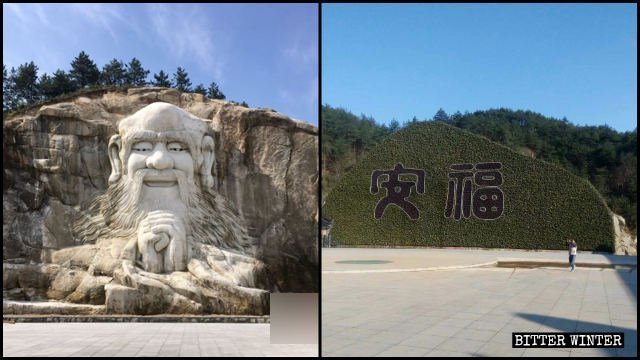Even symbols of traditional Chinese spiritual teachings are not spared in the campaign to eliminate all religions, as Taoist symbols and temples face demolition.
by Tang Zhe
Chinese Taoism – a spiritual practice and philosophy that advocates living a simple life – has been an omnipresent part of China’s civilizational identity since at least the 4th century BC. Albeit being a fragment of the so-called “red market” – the five officially recognized religions in China – Taoism is suppressed increasingly after the new Regulations on Religious Affairs came into force in February last year.
One of the ways the authorities clamp down on Taoism is by demolishing or concealing its symbols and statues, including those of its founder – Chinese philosopher Lao-Tzu (also known as Laozi and Lao Tze).
One such sculpture – Lao-Tzu’s face carved into the Wugong Mountain at the national 4A-level scenic area of Yangshimu in Anfu county, under the jurisdiction of Ji’an city in the southeastern province of Jiangxi – was destined for demolition on October 12, 2018. The local government declared that it violated Article 30 of the Regulations on Religious Affairs, which stipulates that “organizations and individuals other than religious groups, temples, and churches must not construct large outdoor religious statues.” The decision elicited widespread anger among the population and attracted the attention of the media, some reports calling the decision to destroy the sculpture of Lao-Tzu on the grounds of “violating religious policies” as “absurd.”
According to one of the employees at the scenic area, the sculpture was carved in 2017 by Wang Ronghai, a well-known sculptor from Fujian Province. Sixteen meters in width and 23 meters in height, it cost over four million RMB (around $ 560,000). After its completion, the sculpture became the scenic area’s iconic landmark beloved by tourists.
According to local sources, the government’s initial plan was to detonate the sculpture, but the scenic area’s administration objected, fearing that explosion could adversely affect the surrounding area; moreover, the sculpture was across from the entrance to the scenic area’s cableway. After negotiations, the final decision was to conceal it.

In March, the provincial government directed to suspend scenic area’s business for 20 days to hide the sculpture, threatening to impose fines if orders were not implemented properly.
As a result, the park blocked off the sculpture with a sizeable plant-decorated barrier with Chinese characters for the name Anfu (安福) displayed on it.

The staff member at the scenic area also revealed that last October, Ziyun Temple, a Taoist temple located about four kilometers from Yangshimu, was shut down by the government on the grounds that it was “unlicensed.” Taoist statues, incense burners, and a large bell were removed from the temple and abandoned under the temple’s eaves. Four priests were forced to leave the temple, and their current whereabouts are unknown.

The destruction of Taoist temples and symbols is widespread across China. On May 9, Qingyun Temple in Dalian city’s Jinpu new area, in the northeastern province of Liaoning, was sealed off on orders by the local authorities. All items, including Taoist scripture, calligraphy, and paintings, were burned or otherwise destroyed as “illegal publications.” A local believer commented that the Chinese government is “rectifying” religion, just like during the Cultural Revolution. “People have to do whatever the authorities tell them to. Who would dare to oppose them?” the believer said helplessly.
Similarly, Jiulong Temple, a Taoist temple located in Dalian’s Pulandian district, was also sealed off in April. Local government officials locked the entrance to the temple and ordered the person in charge to sign a statement guaranteeing that he won’t sell incense or hold Taoist ritual ceremonies.

Go to Source
Author: Tang Zhe




